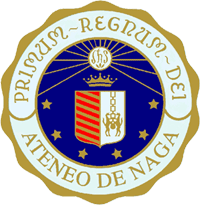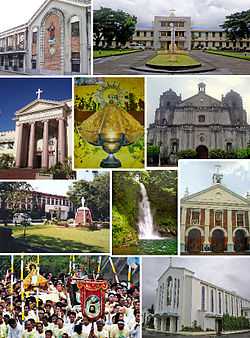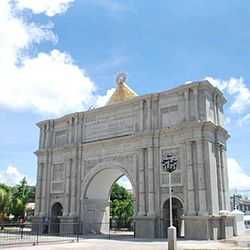Ateneo de Naga University
| Ateneo de Naga University | |
|---|---|
| Pamantasang Ateneo de Naga | |
 The Jesuit university in the Bicol region, Philippines | |
| Latin: Universitas Athenaea Nagensis | |
Former names |
Camarines Sur Catholic Academy (1935-1939) Ateneo de Naga (1940-1998) |
| Motto | Primum Regnum Dei (Latin) |
Motto in English | First, the Kingdom of God |
| Established | 1940 |
| Type | Private Research University |
| Affiliation | Roman Catholic (Jesuit) |
| Chairman | Atty. Monico V. Jacob |
| President | Fr. Primitivo E. Viray Jr., S.J. |
| Principal |
Tita S. Natividad (High School) Josephine C. Abinuman (Grade School) |
Academic staff | 377 |
Administrative staff | 306 |
| Students |
1,500 (High School) 186 (Grade School) |
| Undergraduates | 5,000 |
| Location |
Naga City, Camarines Sur, 13°37′48″N 123°11′3″E / 13.63000°N 123.18417°ECoordinates: 13°37′48″N 123°11′3″E / 13.63000°N 123.18417°E |
| Campus |
Main campus: Bagumbayan Sur (College) Bonoan campus: Barangay Pacol (Grade School and High School) |
| Alma Mater Song | "The Regnum Dei" |
| Colors | Blue and Gold |
| Athletics | Naga City Inter-Collegiate Basketball Tournament |
| Sports | Basketball Volleyball Football Swimming Chess Table Tennis Lawn Tennis Badminton |
| Nickname | Golden Knights |
| Mascot | Golden Knight |
| Affiliations | AJCU-AP JBEC ASEACCU CEAP COCOPEA |
| Website |
www |
The Ateneo de Naga University is a private research university under the supervision of the Society of Jesus in Naga City in the province of Camarines Sur, Philippines. It is also known by the acronym AdNU. It was established in 1940, and is the fourth school named Ateneo opened in the Philippines by the Jesuits. Typical of universities in the Philippines, AdNU has primary, secondary and tertiary levels which are coeducational. However, it was only in school year 2014-15 that the Ateneo de Naga opened its grade school.
History
Early History
The Ateneo de Naga University was established in 1940 when American Jesuits took over the Camarines Sur Catholic Academy, a small private school under the supervision of the Diocese of Nueva Caceres, at the invitation of the bishop of the diocese. The Jesuits changed the name of the school to Ateneo de Naga. During its first year, Ateneo de Naga included the intermediate grades (grades 4-6) of elementary school. In 1941, however, the elementary school students were transferred to the nearby school ran by the Daughters of Charity, a Catholic religious order for women, and the Ateneo was solely an all-male high school up to school year 1946-47. The college department opened with 87 male students in June 5, 1947. Six years later, in October 26, 1953, the college became coeducational with the admission of five female students.[1]
Recent History
The Graduate School which had a brief existence in the seventies, was revived in 1993. In 1997, the Ateneo expanded into four colleges, namely: the College of Arts and Sciences, the College of Commerce, the College of Education and the College of Information Technology and Engineering. In 2001, the College of Computer Studies was established.
University status
The Ateneo de Naga was granted university status by the Commission on Higher Education (CHED) on November 11, 1998. The inauguration as a university was held February 20, 1999. Raul Bonoan, S.J. was the first university president.
Expansion
From 1947 to 2003, the college and high school were located in the same campus. The Bagumbayan campus became crowded when AdNU became a university. Student population grew as the university added more undergraduate programs and built more buildings. In the early 2000s, land in Barangay Pacol, Naga City was donated to AdNU. This property became the new home of the high school in the summer of 2003. Also in 2003 the high school became coeducational and the first 185 female students were enrolled.[2]
Up to the year 2013, Ateneo de Naga was the only Ateneo without a grade school. In June 4, 2014, AdNU opened its grade school at the Bonoan campus in Barangay Pacol, Naga City. Initially for school year 2014-15, Ateneo de Naga accepted grade one to three students. Three sections for Grade 1, two sections for Grade 2 and one section for Grade 3 were opened. A total of 186 students made history as the pioneer students of the Grade School. Classes are being held in provisional classrooms in the High School building until the completion of the new grade school building. Construction of the new kindergarten facility (the Ateneo Child Learning Center) also on the Pacol campus has been completed in 2014 and is being used starting school year 2014-15.
Undergraduate programs
- College of Arts and Science
- College of Business and Accountancy
- College of Computer Studies
- College of Education
- College of Engineering
- College of Nursing[3]
Beloved Jesuits
There are Jesuits who served the Ateneo de Naga for an extended period and contributed much to the growth of the school. Some have been honored by the school by naming buildings and places after them.
These include the late John Joseph Phelan, S.J., the longest serving Jesuit with more than 40 years, for whom the science building was named.[4] The library was named after another long-serving Jesuit, the late James J. O'Brien, S.J..[5]
An academic building, Burns Hall, is named after the late Francis D. Burns, S.J., the first school rector who led the establishment of the Ateneo de Naga in 1940.[6]
In 2013, the Board of Trustees honored two deceased Jesuits who contributed to the development of Ateneo de Naga. In June 5, 2013, during the re-dedication of the Pacol Campus it was renamed Fr. Raul Bonoan, S.J. Campus and the high school building was named after Michael Rooney, S.J.<ref name=515-"Pacol campus renamed grade school site opened in adnu at 75 launch">"Pacol campus renamed grade school site opened in adnu at 75 launch". AdNU.</ref> Earlier in September 12, 2012, a building in the college campus in Bagumbayan was named after Raul Bonoan, S.J., the university's first president.
There are buildings named after Jesuits who did not serve in Ateneo de Naga. The convention hall is named after Pedro Arrupe, S.J., the 28th superior general of the Jesuits (1965–83), and the conference hall after Richard Michael Fernando, a Jesuit scholastic who sacrificed his life to protect his Cambodian students from a grenade blast.[7] The building housing the offices of the student organizations is named after the patron saint of the university, Francis Xavier, S.J.
School seal
The Ateneo de Naga seal is similar to the seals of four other ateneos. It is circular and the school motto in Latin is on top of the circle with the name of the school at the bottom of the circle.
At the center of the Ateneo de Naga University Seal is the escutcheon of the family of St. Ignatius of Loyola, founder of the Society of Jesus. The ahield is divided vertically into two. The right panek shows two wolves on both sides of a hanging cauldron. The design symbolizes the hospitality and generositybof the Loyola family. On the left panel, symbolizing nobility and heroism are seven red bars on a field of gold, honoring the seven heroes of the family who distinguished themselves in the battle of Beotibar in 1321. The shield is part of the seal of many Jesuit schools in the world with which the Ateneo shares a four hundred tradition of Jesuit liberal education.
Immediately above the Loyola escutcheon is a gold crown of Mary, Mother of God, who under the title of Our Lady of Penafrancia, is the patroness of Bicol. Over Mary's crown shines the sun, symbol of Christ. On its face is the seal of the Society of Jesus in calligraphic form: the first three letters in Greek of the Holy Name of Jesus (IHS) with the cross on top and the nails of His Holy Passion underneath. The sun's rays shine over Mary's crown, the Loyola shield, and the six stars and beyond. The Sun, symbol of Christ, truth and life, shines over Mary, Ateneo, Bicol, and the world. Arranged in semi-circle under the shield are six gold stars representing the six provinces of Bicol Region : Camarines Norte, Camarines Sur, Albay, Sorsogon, Catanduanes, and Masbate.<ref name="File:ADNU_seal.png>File:ADNU seal.png - Wikipedia, the free encyclopedia</ref>[8]
School motto
The school motto the Latin phrase, "Primum Regnum Dei" means "First the Kingdom of God" from the Bible verse - Matthew 6:33 "Seek first the kingdom of God and His justice and all things shall be added unto you".[3]
Recognition
In 2001, Ateneo de Naga was among the first 22 private higher education institutions granted deregulated status for a period of five years by CHED. AdNU's various colleges were also given recognition by CHED. In 2007, CHED re-designated the College of Computer Studies as a Center for Development for Excellence in Information Technology Education and designated the College of Commerce as Center of Development in Business Administration and a Center of Development in Entrepreneurship. In the same year, CHED also identified the Graduate School as a delivering institution for its Faculty Development Program. On June 2, 2008 CHED granted Ateneo de Naga autonomous status and approved the designation of the College of Education as a Center of Excellence in Teacher Education.
Accreditation
On May 25, 2009, the Philippine Accrediting Association of Schools, Colleges and Universities (PAASCU) granted institutional accreditation to Ateneo de Naga, a first for a private educational institution.[9] The Federation of Accrediting Agencies of the Philippines (FAAP) certified AdNU's institutional accreditation on June 22, 2009.
University press
The Ateneo de Naga has operated an academic publishing house since 2005 by virtue of the University Memo No. 562 issued by the University President. It operates as an auxiliary unit reporting directly to the University President. Its daily operations are managed by the University Press Director.
The University Press publishes the university research work and accepts outside manuscripts that have been examined by the University Press Board for recommendation to the University President. All publications must have the final approval of the University President.[10]
Student publication
The official tertiary student publication of the university is "The Pillars" which was founded in 1961.[11] The high school student publication is The Blue and Gold.
Notable Alumni
• Jesse Robredo (2010-2012), a stateman who have served as the Secretary of the Interior and Local Government until his death.
• Diosdado Macapagal-Arroyo (2010-present), the congressman of the Second District of Camarines Sur.
References
- ↑ "About Us: History". adnu.edu.ph.
- ↑ Bermudo, Honesto, III. "The Glory that was Bagumbayan, the Grandeur that is Pacol: Ateneo de Naga High School Welcomes 185 Girls in Historic School Opening Rites". Apostolate of the Month. Philippine Jesuit Foundation.
- ↑ 3.0 3.1 Ateneo de Naga University | Ranking & Review
- ↑ http://www.adnu-alum.org/main1/news/0705/frJack2.asp
- ↑ http://www.businessmirror.com.ph/index.php/en/news/opinion/14696-the-legend-of-fr-james-o-brien-sj-the-irish-american-bikolano
- ↑ The Official Website of the Alumni and Alumnae of Ateneo de Naga University
- ↑ Richie Fernando SJ | walk the way
- ↑ "University seal". AdNU.
- ↑ The City of Naga [الأرشيف] - ARAPHIL
- ↑ Ateneo de Naga opens university press with launching of 2 Bikol books « Dagos po sa Maogmang Naga
- ↑ Book Launchings, Art Exhibit in Ateneo « Dagos po sa Maogmang Naga
External links
| Wikimedia Commons has media related to Ateneo de Naga University. |
| ||||||||||||||||
| ||||||||||||||||||
| |||||||||||||||||||||||||||||||||||||||||||
| ||||||||||||||||||||||||||||||||||||||||||


